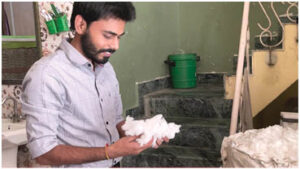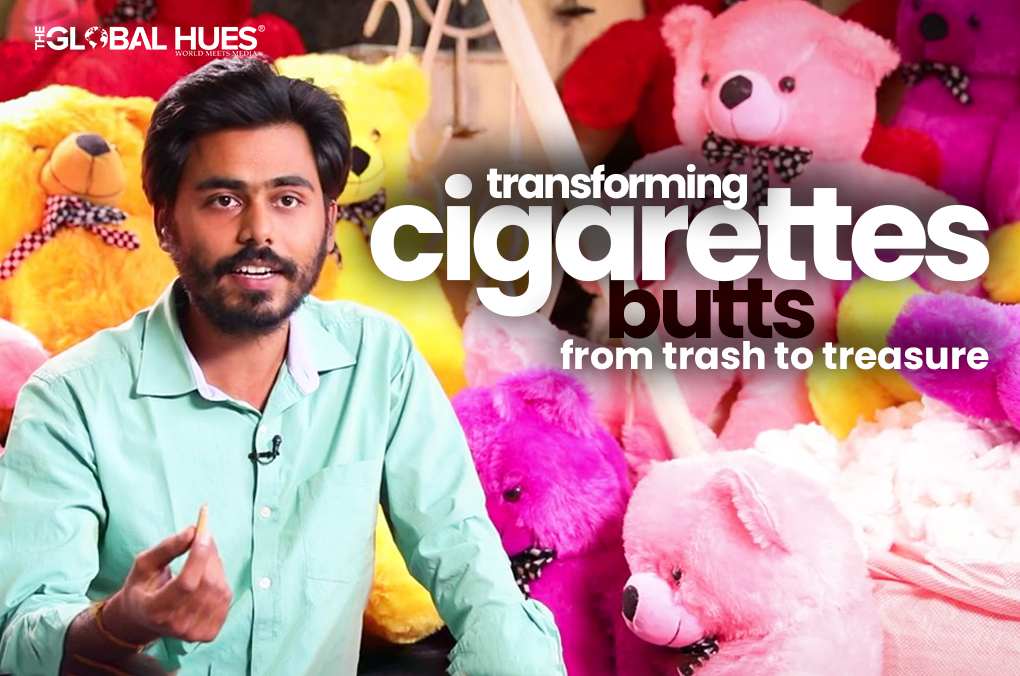Have you ever wondered what happens to cigarette butts after they are discarded on the streets?
The worldwide number of smokers is increasing daily. Smokers are wasting trillions of cigarette butts worldwide, causing serious landfill and economic issues. Despite several campaigns by World Health Organisation and many other NGOs, cigarette butts are infesting the world’s streets and landfills.
When Naman Gupta and his elder brother Vipul Gupta came across this problem, he decided to do something about it. Days of brainstorming sessions between the two led to the inception of India’s First Cigarette Waste Recycling Company in Noida in 2018.
“In 2018, I witnessed a huge number of cigarette butts ending up as general litter in our surroundings. It increased my curiosity about understanding the after-life of cigarette butts. After comprehending, I decided to invent an end-to-end solution to effectively recycle cigarette butts into different products – such as home decor, stationery, toys, and more. Code Effort is an entirely new venture for me and a first-mover in the Indian market,” says Naman with pride.
The Recycling Process of Cigarette Butts
After the firm’s inception, the founders joined hands with rag pickers to collect cigarette waste. Code also provides Value Bins in public spaces for waste collection.
After collecting the cigarette waste, butts are separated into three parts -Polymer, Leftover tobacco & paper, and fly ash. For the air purification process, the polymer is used, followed by recycling the organic leftover tobacco and paper into organic manure. The fly ash ends up in storage.
The firm recycles each component of the cigarette to ensure that the end product is safe. Additionally, it reduces the water generated throughout the process to a carbon footprint.
The company utilises recycled fibres as filling material in hand-made accessories, artefacts, cushions, furniture items, mattresses, pillows, toys, and many more.
It utilises 100% natural microorganisms to decompose tobacco, converting it into compost powder. To prevent any harm to the soil and groundwater, the composting method is aerobic, unlike traditional anaerobic processes. This ensures that the leachate does not have any detrimental effects.
The paper is ground into a pulp and later formulated into mosquito repellents using specialised ingredients and fragrances.
Features of Recycled Paper Products
Code develops recycled paper products such as stationery, packaging, and more from recycled cigarette waste paper. The USP of being made from cigarette waste is primary. Its recycled paper products (brochures, packaging paper, envelopes, letterheads, diaries, notepads, and more) come with the following features:
- Customised thickness starting from 130 GSM to 250 GSM
- The standard sheet size of 30×20 inches – sizeable as required
- Colour as required
- Shelf life of 2+ years
- Plant-able
- Recyclable up to 8 times
“Every idea looks promising on paper, but a proactive response from people determines the success. Fortunately, in our case – we have received positive responses from all the key stakeholders, including individuals, corporations, institutions, and government officials. Moreover, media and publications houses across the globe have driven our cause and helped us reach the masses through their extensive networks,” add Naman and Vipul.
Safety First

Code recycles cigarette fibres using completely biodegradable and organic chemical compositions. After treatment, the materials undergo a quality and lab-testing process before further application. Its closed-loop recycling process ensures 100% utilisation of the materials, NET ZERO carbon footprints, and fosters a circular economy.
“Our recycling process is ISO 9001:2015, ISO 14001:2015, ISO 45001:2018, and GRS certified. These certifications validate our adherence to strict quality standards, and we also conduct regular quality checks to ensure consistent compliance,” says Naman.
Expansion Of Procurement And Recycling Capacity
Code envisions a significant expansion of its procurement and recycling capacity, aiming to increase it from 30 to 300 tonnes per month by 2025. As a raw material, Cigarette butts have immense properties and applications. Over the next three years, the founders believe that B2B and ESG/EPR/CSR initiatives will form 75% of the company’s revenues. Additionally, they are confident that their direct-to-consumer (D2C) brand will resonate strongly with environmentally-conscious individuals from Generation Y and Generation Z.
While signing off, the brothers mention, “We employ and provide a livelihood to 100+ women and local artisans at our factory in Noida, Uttar Pradesh and plan to employ more in the coming years.”
Read More Inspiring Stories:
- Vrikshit Foundation: An NGO Encouraging Masses To Strive For A Healthier India
- Here’s Why Shubhi’s Unique Approach To Managing Traffic Is Doing Wonders
- Meet 68-Year-Old Doctor-Model Who Is An Inspiration To Many
- Echoes: A Cafe That Converses Without Any Language
- Meet The Man Behind Female Voice Of Railway Announcements




